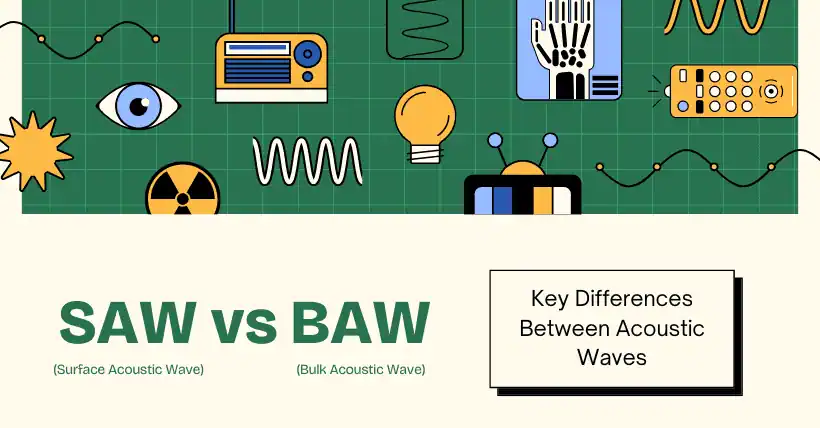SAW (Surface Acoustic Wave) and BAW (Bulk Acoustic Wave) are two technologies commonly used in RF filters, and they differ significantly in terms of frequency response, loss, and applicable frequency bands.
01
Differences in Operating Principles Between SAW and BAW
SAW (Surface Acoustic Wave): SAW filters operate based on the propagation characteristics of surface waves, where signals propagate on the surface of the wafer and are filtered after an electro-acoustic conversion. The core of this technology is to convert the electrical signal into an acoustic signal and then convert the acoustic signal back into an electrical signal. The main feature of this technology is the use of surface waves, making it suitable for lower frequency signals.
BAW (Bulk Acoustic Wave): BAW filters rely on the characteristics of bulk waves (acoustic waves propagating inside the crystal). Unlike SAW, the acoustic waves in BAW technology propagate through the entire volume of the crystal, not just the surface. This technology allows it to operate in higher frequency ranges, typically used for high-frequency signal processing. FBAR is a type of BAW filter.
02
Frequency Range and Loss
SAW Filter: SAW filters are typically used in the mid-to-low frequency range, generally suitable for frequency bands from a few hundred MHz to 2.5 GHz, and are widely used in mobile communications and consumer electronics. Due to the limitations of its operating principle, SAW filters have higher losses, especially at higher frequencies, where performance significantly deteriorates.
BAW Filter: BAW filters can support higher frequency bands, typically used in the 2 GHz to several tens of GHz range, making them more suitable for high-frequency applications. The advantages of BAW include lower loss and a broader frequency response, capable of handling higher frequency signals, which is particularly important in 5G communications.
03
Application Range
SAW Filter: Due to its low-frequency characteristics, SAW filters were widely used in the 4G era, with a mobile phone often requiring multiple SAW filters. They are very common in low-frequency RF applications such as mobile phones, GPS devices, etc.
BAW Filter: BAW filters are more suited to the high-frequency demands of the 5G era, commonly used in high-frequency communication devices, base stations, and high-frequency mobile devices. With the widespread adoption of 5G technology, the application of BAW is growing rapidly.
04
Technological Development and Market
SAW Technology: Currently, SAW technology is mainly led by Japanese manufacturers, particularly advantageous in data processing at mid-to-low frequencies. It has a broad market application, especially for low-cost products.
BAW Technology: BAW technology is primarily led by American manufacturers, with a significant advantage in high-frequency data processing. The technology is more difficult and costly to manufacture, but its application value is relatively higher. With the development of 5G technology, the market demand and value for BAW filters are rapidly increasing.
05
Manufacturing Materials and Costs
SAW Filter: Typically uses piezoelectric materials such as lithium tantalate and lithium niobate, with relatively mature manufacturing processes and lower costs.
BAW Filter: Commonly uses piezoelectric materials like aluminum nitride, which has a higher manufacturing difficulty and cost, suitable for higher-demand RF applications.
Summary: The main differences between SAW and BAW are in their operating principles, frequency ranges, losses, and application fields. SAW is suitable for mid-to-low frequency applications, with lower costs and broader market applications, while BAW is better suited for high-frequency applications, particularly in the 5G era, where its low loss and high-frequency response characteristics will play an increasingly important role.

Disclaimer:
- This channel does not make any representations or warranties regarding the availability, accuracy, timeliness, effectiveness, or completeness of any information posted. It hereby disclaims any liability or consequences arising from the use of the information.
- This channel is non-commercial and non-profit. The re-posted content does not signify endorsement of its views or responsibility for its authenticity. It does not intend to constitute any other guidance. This channel is not liable for any inaccuracies or errors in the re-posted or published information, directly or indirectly.
- Some data, materials, text, images, etc., used in this channel are sourced from the internet, and all reposts are duly credited to their sources. If you discover any work that infringes on your intellectual property rights or personal legal interests, please contact us, and we will promptly modify or remove it.



